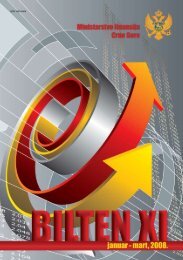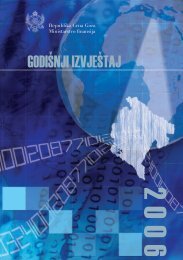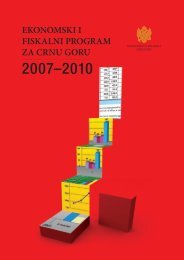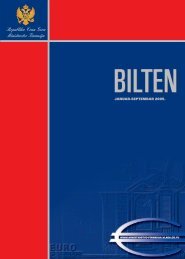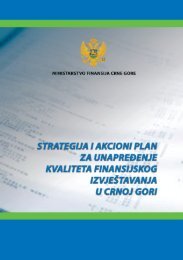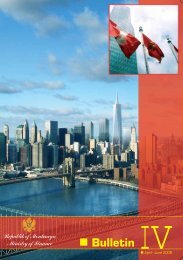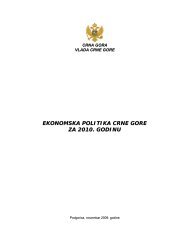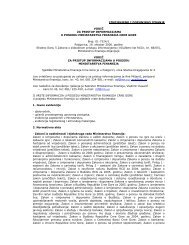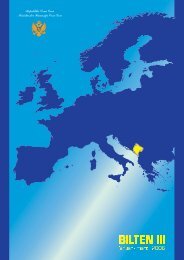director - Ministarstvo finansija
director - Ministarstvo finansija
director - Ministarstvo finansija
You also want an ePaper? Increase the reach of your titles
YUMPU automatically turns print PDFs into web optimized ePapers that Google loves.
World Bank and<br />
Relations with the WB<br />
The World Banks (WB) was founded in<br />
1944 as an International Bank for Reconstruction<br />
and Development (IBRD).<br />
Its original mission was to finance the reconstruction<br />
of nations devastated by the World<br />
War II and at that moment it had 38 members.<br />
The number has been increased to current<br />
184 members. The World Bank is present<br />
in 100 countries, having 10.600 employees<br />
world wide.<br />
World Bank Group consists of five closely<br />
associated institutions:<br />
1. The International Bank for Reconstruction<br />
and Development (IBRD) offers loans to<br />
mid-income countries. The funds for this lending<br />
come primarily from the issuing of its<br />
bonds on the global capital markets.<br />
2. International Development Association<br />
(IDA) offers assistance to the poorest<br />
countries with a per capita income of less<br />
than US$ 885, by providing interest-free<br />
loans, technical assistance and policy advices<br />
on national economy management. .<br />
3. International Finance Corporation<br />
(IFC) promotes growth in member countries<br />
through private sector and real investments.<br />
4. Multilateral Investment Guarantee<br />
Agency (MIGA) promotes the flow of foreign<br />
direct investment among member countries<br />
by insuring investors against non-commercial<br />
(political) risk, and by providing promotional<br />
and advisory services to help member<br />
countries create an attractive investment climate.<br />
5. The International Centre for Settlement<br />
of Investment Disputes (ICSID) provides<br />
facilities for conciliation and arbitration<br />
of investment disputes between Contracting<br />
States and nationals of other Contracting States.<br />
Ex-SFRY was a member country of all<br />
these five affiliations of the World Bank<br />
Group.<br />
International Bank for Reconstruction<br />
and Development (IBRD) was founded in<br />
1944 at the Bretton Woods Conference simultaneously<br />
with the International Monetary<br />
Fund. Yugoslavia was one of the 38 founding<br />
countries of the two international financial<br />
organizations. Upon signing documentation<br />
in Washington on 27 December<br />
1945, Yugoslavia formally joined the Bank<br />
and Fund.<br />
Following break up of former SFRY, manner<br />
of refinancing of outstanding liabilities<br />
resulting from previously used loans was<br />
agreed upon for the SRY.<br />
On 25 February 1993, the Board of Executive<br />
Directors of the International Bank for<br />
Reconstruction and Development adopted<br />
the Resolution No. 93-2, regulating the question<br />
of cessation and succession of the SFRY<br />
membership to this institution, according to<br />
which SRY participates with 36,52% in share<br />
of capital.<br />
State Union Serbia and Montenegro renewed<br />
membership to the World Bank in<br />
May 2001.<br />
Relations with World Bank<br />
Jadranka Radunović<br />
BULLETIN OF THE MINISTRY OF FINANCE/JANUARY-MARCH 2006<br />
Regulation of outstanding liabilities to<br />
the IBRD has opened a perspective for new<br />
borrowing. Serbia and Montenegro, as a<br />
country highly burdened with debts, was<br />
granted the IDA status in period from 2001-<br />
2004, enabling it to contract debts with the<br />
International Development Association<br />
(IDA) under favourable terms<br />
Review of Financial Arrangements<br />
with the World Bank<br />
Following renewal of the membership,<br />
the World Bank has approved Montenegro<br />
credit funds for macroeconomic stability,<br />
market economy development and implementation<br />
of infrastructure projects.<br />
In addition to contacts with the WB representatives<br />
stemming from the above financial<br />
arrangements, representatives of the<br />
Government of the Republic of Montenegro<br />
held meetings in March 2004 with the International<br />
Finance Corporation (IFC), in Istanbul<br />
concerning unsettled claims of beneficiaries<br />
of other IFC loans from the territory of<br />
the Republic of Montenegro. It was agreed,<br />
inter alia, that the Government should assume<br />
unsettled claims of legal persons to the<br />
IFC, and that the IFC should write-off outstanding<br />
debt interest, including default interest.<br />
It was also agreed that the consolidated<br />
debt - other IFC loans should be settled<br />
by conversion of part of the debt into 10% of<br />
share capital of the Podgorička banka, while<br />
the remaining part of the debt should be<br />
paid in 18 semiannual installments in a way<br />
specified under the Agreement between the<br />
Government and the IFC signed in mid April<br />
2005.<br />
Two credits extended by the World Bank<br />
to Serbia and Montenegro in the previous<br />
period are particularly noteworthy: Structural<br />
Adjustment Credit I and Structural Adjustment<br />
Credit II.<br />
The SAC I amounting USD 15 million was<br />
approved to Montenegro in 2002 for the<br />
purpose of providing support to reforms in<br />
various fields, whose middle-term objective<br />
was establishing macroeconomic stability,<br />
stimulating growth and improving social situation.<br />
This credit was fully realized.<br />
The SAC II was approved to Serbia and<br />
Montenegro in 2004. USD 18 million of credit<br />
funds were allocated for the Republic of<br />
Montenegro. The credit is intended for the<br />
reform of financial, pension and healthcare<br />
system, including other areas as well. Delegation<br />
of the World Bank set conditions which<br />
are to be met for the realization of the credit,<br />
relating to implementation of reforms in the<br />
said fields. Planned reforms in the financial<br />
sector will enhance transparency of overall financial<br />
sector; and strengthen institutional<br />
capacity and accountancy of key public sec-<br />
27





